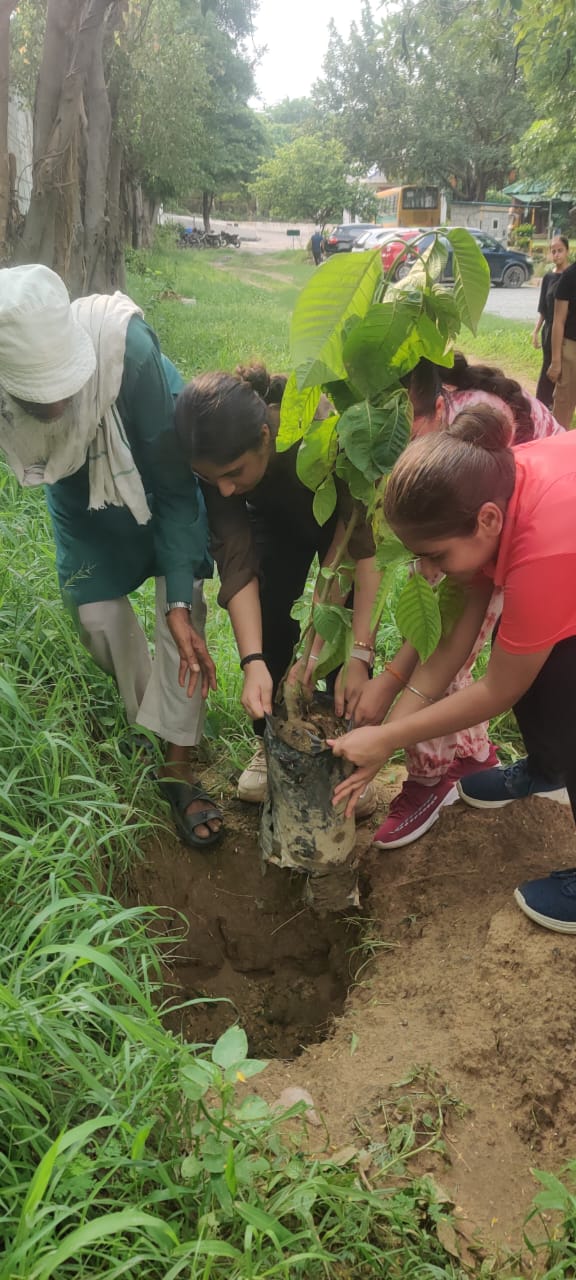Camp Wild Retreat Aravali Valley was a significant step towards environmental conservation. This initiative, aimed at offsetting carbon footprints, had multiple educational, ecological, and social benefits.
1. Offsetting Carbon Footprints
- The concept of “carbon footprint” refers to the total amount of greenhouse gases emitted by human activities, contributing to climate change. By planting trees, the students directly contributed to reducing carbon emissions. Trees absorb carbon dioxide during photosynthesis, acting as carbon sinks and helping mitigate the effects of climate change. This initiative was part of the school’s effort to raise awareness and take practical steps to reduce its environmental impact.
2. Educational Experience in Sustainability
- The activity provided a hands-on learning experience about sustainability and environmental stewardship. Students learned about the ecological significance of trees, especially indigenous species like neem and mango, which are vital to local biodiversity. Understanding how trees contribute to air and water purification, as well as the role they play in maintaining ecological balance, gave students practical knowledge that they can apply in their daily lives.
3. Promotion of Indigenous Species
- The tree plantation involved the planting of indigenous species, such as neem and mango. Indigenous trees are better suited to the local climate and soil conditions, and they support local wildlife, including birds, insects, and small mammals. By focusing on native species, the initiative helped maintain the region’s biodiversity and fostered a deeper understanding of the importance of preserving local ecosystems.
4. Fostering Environmental Responsibility
- The tree plantation activity instilled a sense of environmental responsibility in the students. It made them realize that even small actions, such as planting a tree, can have a lasting impact on the environment. The students were encouraged to reflect on their personal carbon footprints and take steps to reduce their environmental impact, such as conserving water, reducing waste, and using renewable energy sources.
5. Teamwork and Camaraderie
- The activity was conducted in teams, fostering collaboration and teamwork among the students. As they worked together to plant trees, they developed a sense of camaraderie and shared purpose. This teamwork not only made the experience more enjoyable but also highlighted the importance of collective action in achieving environmental goals. It reinforced the idea that environmental conservation is a collective responsibility.
6. Interactive Sessions on Environmental Conservation
- In addition to tree planting, the students participated in interactive sessions on environmental conservation and wildlife protection. These sessions provided them with a broader understanding of the challenges facing the planet and the steps they can take to address these challenges. They learned about sustainable living practices, such as reducing waste, conserving water, and protecting endangered species, which will empower them to advocate for environmental causes in their communities.
7. Connection with Nature
- The event took place in the beautiful Aravali Valley, providing students with the opportunity to connect with nature. In today’s technology-driven world, many young people are disconnected from the natural environment. The outdoor setting allowed students to experience the beauty of nature firsthand, fostering a sense of appreciation for the environment and its importance in their lives. This connection with nature is essential for cultivating long-term environmental awareness.
8. Promoting Sustainable Practices
- Through the tree plantation and educational sessions, the students learned about sustainable practices that can be implemented in their daily lives. From reducing energy consumption to adopting waste management practices, the students gained practical knowledge on how to live more sustainably. This is crucial for building a generation that is conscious of its environmental footprint and committed to adopting green practices.
9. Collaboration Between Schools and Local Communities
- The collaboration between Guru Nanak Public School and Camp Wild Retreat exemplifies the power of partnerships in addressing environmental challenges. By working together, educational institutions and local organizations can create meaningful and impactful initiatives that benefit both students and the community. This collaboration helped provide the students with a unique, immersive learning experience that went beyond traditional classroom education.
10. Long-Term Environmental Impact
- The tree plantation activity is a long-term investment in the environment. While the immediate impact of planting trees may seem small, over time, these trees will grow, provide shade, improve air quality, and support local wildlife. The initiative contributes to the long-term greening of the Aravali Valley and serves as a model for future environmental conservation efforts.
11. Building Future Environmental Leaders
- By engaging students in environmental conservation activities, the school is helping to cultivate future environmental leaders. The students gained not only knowledge but also the motivation to become advocates for the environment in their communities. This is essential for building a generation that will take proactive steps to address the environmental challenges facing the planet.
12. Inspiring Other Schools and Communities
- The success of this initiative can serve as an inspiration to other schools and communities to undertake similar environmental activities. By showcasing the positive impact of tree planting and environmental education, Guru Nanak Public School’s initiative encourages others to follow suit, multiplying the efforts to create a greener, more sustainable world.
Conclusion:
The tree plantation activity at Camp Wild Retreat by Guru Nanak Public School was a multi-faceted event that provided students with an educational, practical, and emotional connection to environmental conservation. Through their efforts, the students not only contributed to greening the Aravali Valley but also gained invaluable insights into sustainable living practices and the importance of protecting the environment. This initiative is a step towards building a more sustainable future, where every individual plays a part in creating positive change – one tree at a time.


Leave a Reply